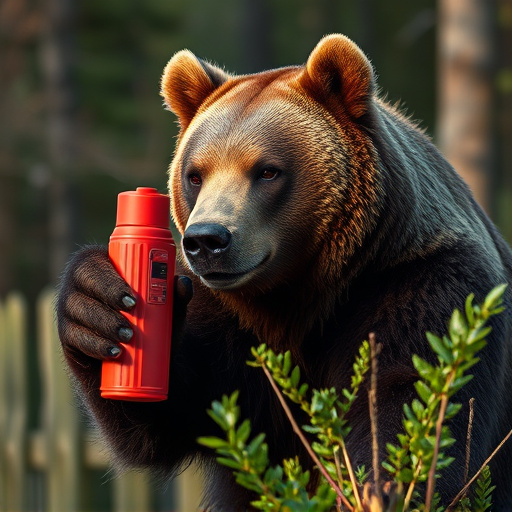Bear spray, utilizing capsaicin, is a crucial safety measure in bear country, effective against aggressive bears when used correctly as a last resort. Key aspects include recognizing behavioral cues, aiming at the bear's face and eyes from a safe distance, proper application technique (short bursts, 2-3 seconds), and immediate post-encounter care including moving away, proper disposal, medical attention for injuries, and gear cleaning. Practicing usage techniques beforehand is vital for optimal effectiveness as a life-saving tool. Always keep bear spray within reach during future encounters.
“Bear spray, a powerful defense mechanism, offers hikers and outdoor enthusiasts a crucial tool in potentially life-saving situations. This article delves into the intricacies of bear spray, exploring its composition, effectiveness, and optimal usage. We guide you through recognizing when to deploy this defense, providing techniques for maximum impact, and offering post-encounter care advice. Discover the proper application methods to ensure your safety in the wild, understanding when to use bear spray effectively and responsibly.”
- Understanding Bear Spray: What It Is and How It Works
- When to Deploy Bear Spray: Recognizing the Right Moments
- Effective Application Techniques for Maximum Stopping Power
- Post-Encounter Care and Safety Measures After Using Bear Spray
Understanding Bear Spray: What It Is and How It Works
Bear spray, also known as bear repellent, is a crucial defense mechanism for individuals venturing into bear country. It’s a powerful tool designed to deter aggressive bears when faced with an encounter. This aerosol spray contains capsaicin, the active ingredient found in chili peppers, which irritates a bear’s eyes, nose, and respiratory system. When used properly, bear spray can provide valuable time and distance for individuals to escape potentially dangerous situations.
Understanding how and when to use bear spray is essential. It should be employed as a last resort when a bear exhibits defensive or aggressive behavior, such as charging or making loud noises. The key to its effectiveness lies in the proper application technique: aiming at the bear’s face and eyes from a safe distance. With the right usage, bear spray can significantly increase survival chances during encounters with these majestic yet potentially dangerous animals.
When to Deploy Bear Spray: Recognizing the Right Moments
When to Deploy Bear Spray is a crucial consideration for anyone venturing into bear country. Understanding the right moments to use it can significantly enhance safety and effectiveness. The key lies in recognizing the behavioral patterns of bears and knowing when they pose an immediate threat. For instance, if you encounter a bear that does not seem aware of your presence, remaining calm and slowly backing away is often the best course of action. However, if the bear shows signs of aggression, such as charging or making loud noises, deploying bear spray becomes essential. Proper usage involves aiming for the bear’s face and eyes to ensure maximum stopping power.
Knowing when to use bear spray properly also depends on the type of bear encounter. Black bears typically react defensively only when cornered or surprised, so a calm retreat is often possible. In contrast, grizzly bears are more aggressive and may see humans as a threat, making swift and decisive action with bear spray crucial. Always carry it in an easily accessible location, ensure it’s well-maintained, and familiarize yourself with its operation before venturing into potential bear habitats.
Effective Application Techniques for Maximum Stopping Power
To achieve maximum stopping power with bear spray, understanding and practicing effective application techniques is crucial. When to use bear spray properly involves recognizing the right moment to deploy it. This typically occurs when a bear exhibits aggressive or defensive behavior, such as charging, growling, or swatting at close range. At this point, aiming for the bear’s face and eyes can cause temporary blindness and disorientation, providing an opportunity to escape.
Proper application includes holding the can upright, keeping a safe distance, and spraying in short bursts. Aiming for the bear’s face ensures direct contact with irritants, while bursts of 2-3 seconds are recommended. It’s essential to practice these techniques before encountering bears in the wild, as it can be a game-changer in potentially life-threatening situations.
Post-Encounter Care and Safety Measures After Using Bear Spray
After using bear spray, it’s crucial to take immediate steps for post-encounter care and safety. First, ensure you move away from the area at a safe distance, ideally doubling your current distance from the bear. Check if the bear has left the area; if not, keep moving away slowly while facing the bear but avoiding direct eye contact. Seek medical attention promptly if injured during the encounter, as bear spray can cause irritation or more severe reactions.
Proper disposal of the bear spray is also essential. Follow local guidelines for hazardous waste disposal to ensure it’s handled and disposed of safely. Clean any gear or clothing contaminated by the spray with warm water and soap. In future encounters, always carry bear spray within easy reach, and familiarize yourself with its proper usage techniques. Remember, when used correctly, bear spray can be a life-saving tool, but it requires responsible handling and post-use precautions for maximum effectiveness.
Bear spray is a powerful tool for self-defense in bear country, but its effectiveness hinges on proper usage. Understanding when and how to deploy it, along with effective application techniques, ensures maximum stopping power. By recognizing the right moments and following post-encounter care measures, you can enhance your safety during potential bear encounters. Remember, knowledge is key; armed with the right information, you’ll be better equipped to navigate these wild situations.
